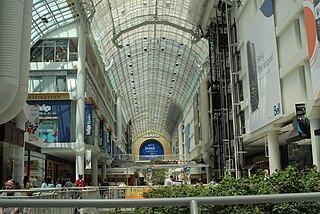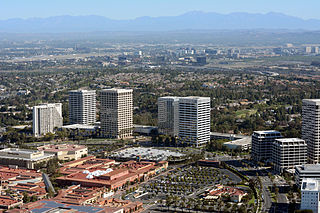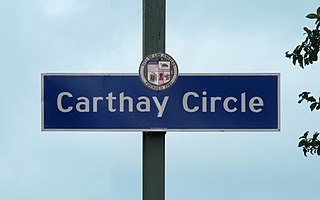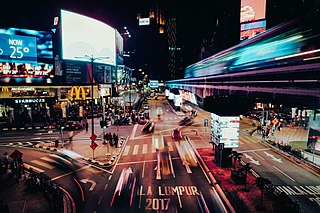
A shopping mall is a North American term for a large indoor shopping center, usually anchored by department stores. The term "mall" originally meant a pedestrian promenade with shops along it, but in the late 1960s, it began to be used as a generic term for the large enclosed shopping centers that were becoming commonplace at the time. In the U.K., such complexes are considered shopping centres, though "shopping center" covers many more sizes and types of centers than the North American "mall". Other countries may follow U.S. usage while still others follow U.K. usage. In Canadian English, and often in Australia and New Zealand, the term 'mall' may be used informally but 'shopping centre' or merely 'centre' will feature in the name of the complex. The term 'mall' is less-commonly a part of the name of the complex.

A shopping center or shopping centre or mall, also called a shopping complex, shopping arcade, shopping plaza or galleria, is a group of shops built together, sometimes under one roof.

Pedestrian zones are areas of a city or town reserved for pedestrian-only use and in which most or all automobile traffic is prohibited. Converting a street or an area to pedestrian-only use is called pedestrianisation.

Ontario Mills is a shopping and outlet mall located in Ontario, California, within the Los Angeles metropolitan area. With 28 million annual visitors, it is one of the top shopping and tourist destinations in California. It is one of three Mills landmarks in California that are now managed by Simon Property Group since April 2007. Simon owns 50% of it. The Outlets at Orange and The Great Mall are the others. Ontario Mills was designed by the architectural firm, F+A Architects.

A strip mall, strip center or strip plaza is a type of shopping center common in North America where the stores are arranged in a row, with a sidewalk in front. Strip malls are typically developed as a unit and have large parking lots in front. Many of them face major traffic arterials and tend to be self-contained with few pedestrian connections to surrounding neighborhoods. Smaller strip malls may be called mini-malls, while larger ones may be called power centers or big box centers. In 2013, The New York Times reported that the United States had 65,840 strip malls. In 2020, The Wall Street Journal wrote that in the United States, despite the continuing retail apocalypse starting around 2010, investments and visitor numbers were increasing to strip malls.

Victor David Gruen, born Viktor David Grünbaum, was an Austrian-American architect best known as a pioneer in the design of shopping malls in the United States. He is also noted for his urban revitalization proposals, described in his writings and applied in master plans such as for Fort Worth, Texas (1955), Kalamazoo, Michigan (1958) and Fresno, California (1965). An advocate of prioritizing pedestrians over cars in urban cores, he was also the designer of the first outdoor pedestrian mall in the United States, the Kalamazoo Mall.

Fashion Island is an outdoor regional shopping mall in Newport Beach, California. Opened in 1967 by The Irvine Company as the anchor to their master-planned Newport Center district, Fashion Island is anchored by Bloomingdale's, Macy's, Neiman Marcus, and Nordstrom.

Pedestrian malls, also known as pedestrian streets, are the most common form of pedestrian zone in large cities in the United States. They are typically streets lined with storefronts and closed off to most automobile traffic. Emergency vehicles may have access at all times and delivery vehicles may be restricted to either limited delivery hours or entrances on side streets.

Carthay Circle is a neighborhood in the Mid-City West region of Central Los Angeles, California. Originally named Carthay Center, the neighborhood was later renamed after the famed Carthay Circle Theatre.

Bukit Bintang is the shopping and entertainment district of Kuala Lumpur, Malaysia. It encompasses Jalan Bukit Bintang and its immediate surrounding areas. The area has long been Kuala Lumpur's most prominent retail belt that is home to many landmark shopping centres, al-fresco cafés, bars, night markets, food street, mamak stalls as well as hawker-type eateries. This area is popular among tourists and locals, especially among the youths.

Gateway Mall is a shopping mall located within the Araneta City in Cubao, Quezon City, Philippines. Owned and operated by the Araneta City, Inc., a subsidiary of the Araneta Group, the mall was completed in 2004 and has 100,000 m2 (1,100,000 sq ft) of total floor area. The Gateway Mall also currently sits on the northern area of the Araneta City, located at the northern end of the historic Araneta Coliseum and attracts over 220,000 shoppers daily, due to its close proximity to transport terminals and train stations.

South Carthay is a neighborhood in Central Los Angeles, California. Located south of Carthay Circle, South Carthay was developed in the 1930s by Spyros George Ponty.
The Linda Vista Shopping Center is a neighborhood shopping center San Diego and one of the first in the United States, built in 1943. It was predated in California only by the Broadway & 87th Street shopping center in South Los Angeles opened in seven years earlier in 1936.
NoHo West is a mixed-use complex in North Hollywood, Los Angeles. Developed on the 25-acre site (10 ha) of the former Laurel Plaza regional shopping mall, the development includes residential units, commercial offices and pedestrian-oriented shops and restaurants. Groundbreaking for NoHo West began in April 2017. The development was planned to be completed in phases. The Macy's department store was converted into 500,000 square feet (46,000 m2) of office space. Major retail tenants that were announced prior to opening included 24 Hour Fitness, Regal Cinemas, Old Navy, and Trader Joe's.
Honer Plaza, now the Bristol Marketplace, at 17th and Bristol streets in northwestern Santa Ana, California, was one of the first shopping centers in Orange County, California and one of the busiest in the county in its early days. Plans were announced for its construction in 1953 and it opened in 1958, starting with a 40,000-square-foot (3,700 m2) Ralphs supermarket. Other anchor tenants over the 1950s-1980s included Montgomery Ward, Long Beach-based Robert's department store, Nahas department store, and J. J. Newberry. By the 1980s, the center was outdated in design — two rows of stores with a small pedestrian mall in the center, surrounded by acres of parking — and had lost business to more modern malls including Fashion Square/MainPlace and The City Shopping Center in Orange.
The Broadway & 87th Street shopping center designed by Wisstein Bros. and Surval, was one of the earliest shopping centers in Los Angeles, built in stages between 1936 and 1939 at 8701–8765 South Broadway between 87th and 88th streets, in what is now termed the Broadway-Manchester neighborhood. Researcher and author Richard Longstreth calls it the first true neighborhood shopping center.
Town & Country Market was shopping center in the Fairfax District of Los Angeles, at the southeast corner of Third and Fairfax, across Third from Farmer's Market. it incorporated elements of a farmer's market but profiled itself as a "small town of 100 smart shops". Opened in 1942, author Richard Longstreth, who calls it an example of the "shopping court", notes that it was one of the first shopping centers in Los Angeles built with parking lots for customers arriving by car, being much larger than the earlier Broadway & 87th Street shopping center and preceding the larger Broadway-Crenshaw Center by 5 years. It was more regular in plan and more pretentious in appearance than Farmer's market across the street. It promoted its entertainment and had 26 restaurants onsite, in this sense a precursor to the lifestyle center of today. The market opened on May 14, 1942.

Retail in Southern California dates back to its first dry goods store that Jonathan Temple opened in 1827 on Calle Principal, when Los Angeles was still a Mexican village. After the American conquest, as the pueblo grew into a small town surpassing 4,000 population in 1860, dry goods stores continued to open, including the forerunners of what would be local chains. Larger retailers moved progressively further south to the 1880s-1890s Central Business District, which was later razed to become the Civic Center. Starting in the mid-1890s, major stores moved ever southward, first onto Broadway around 3rd, then starting in 1905 to Broadway between 4th and 9th, then starting in 1915 westward onto West Seventh Street up to Figueroa. For half a century Broadway and Seventh streets together formed one of America's largest and busiest downtown shopping districts.
Carmel Plaza is a 111,980 sq ft (10,403 m2) self-described "upscale, outdoor lifestyle shopping center" in Carmel-by-the-Sea, California in the block bounded by Ocean, Junipero, Mission and 7th streets. It is currently anchored by Sur la Table, and Anthropologie and is home to luxury goods retailers such as Tiffany. Three stories of shops surround an open-air courtyard.

The Los Angeles Mall is a small shopping center and series of plazas at the Los Angeles Civic Center, between Main and Los Angeles Streets on the north and south sides of Temple Street, connected by both a pedestrian bridge and a tunnel. It features Joseph Young's sculpture Triforium, a colorful sculpture unveiled in 1975, which has 1,500 blown-glass prisms synchronized to an electronic glass bell carillon. The mall opened in 1974 and includes a four-level parking garage with 2,400 spaces. It stands on the site of what once was some of the oldest commercial blocks in the city that was demolished in the 1940s and 1950s.















